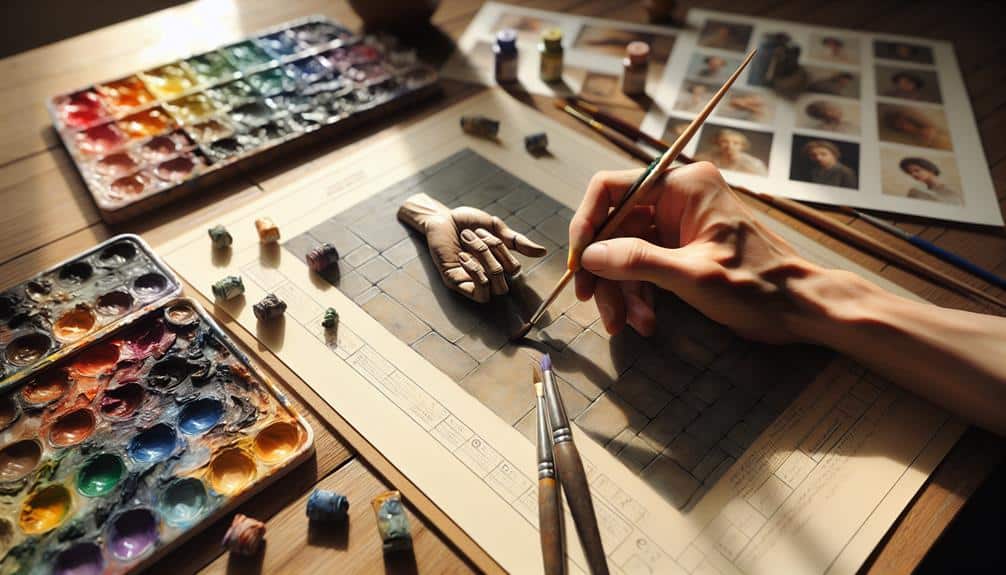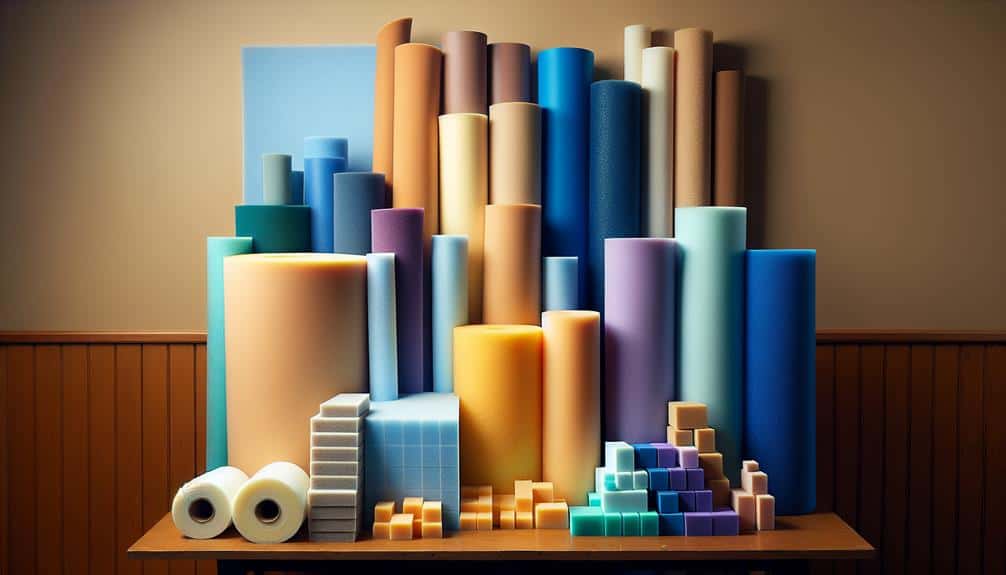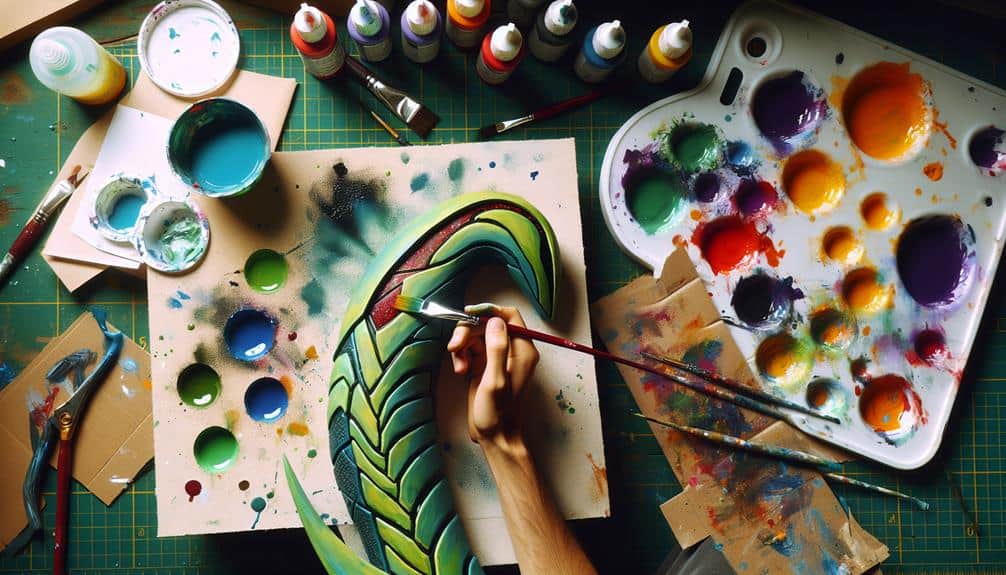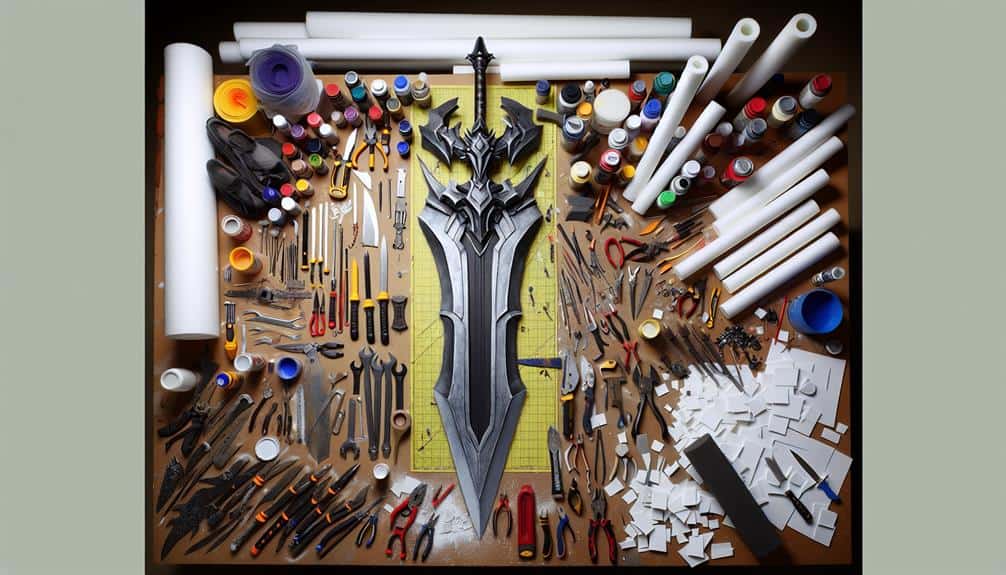Have you ever wondered how professional prop painters achieve such realistic finishes?
The key lies in mastering five essential techniques that can elevate your prop painting game to a whole new level. From preparing the surface to adding layers for depth and texture, each step plays an important role in creating a lifelike appearance.
But the real magic happens when you uncover the secrets behind weathering and aging effects, transforming your props into authentic pieces of art.
Stay tuned to discover the final technique that will seal the deal and protect your masterpiece for years to come.
Key Takeaways
- Use precise surface preparation and base coating techniques for a flawless foundation.
- Layer paints strategically to create depth and realism in prop painting.
- Employ weathering and aging effects for authentic and weathered prop appearances.
- Seal and protect the finished prop with suitable clear coats for lasting quality.
Preparing the Prop Surface
To achieve a professional finish when painting a prop, it's important to thoroughly prepare the surface beforehand. Surface priming plays a vital role in making sure that the paint adheres properly and lasts longer. Begin by cleaning the prop to remove any dust, dirt, or grease that could impact the adhesion of the primer. Once clean, apply a suitable primer that's compatible with the material of the prop. This will create a smooth and uniform surface for the paint to stick to, enhancing the overall look and durability of your work.
When it comes to masking techniques, precision is key. Use painter's tape to cover areas that you want to protect from paint splatter or overspray. Make sure that the tape is firmly pressed down to prevent any seepage underneath. For intricate designs or patterns, consider using stencils to achieve clean lines and sharp edges. By mastering these masking techniques, you can elevate the level of detail and professionalism in your prop painting projects.
Base Coating for Realism
For achieving a realistic finish in prop painting, starting with a well-executed base coat is essential to establish a solid foundation for the intricate details to come alive. When base coating, focus on blending colors seamlessly to create a smooth shift between shades. This initial layer sets the stage for the depth and realism you aim to achieve.
Make sure the base coat is applied evenly, using techniques like airbrushing or hand brushing, depending on the desired effect. Pay close attention to highlighting details that will enhance the overall look of the prop. By strategically adding lighter tones to areas that catch the most light, you can create a sense of dimension and realism.
Blending colors effectively during the base coat phase is critical for setting the tone of your prop painting. Take your time to guarantee a flawless base, as this will make the subsequent layers easier to apply. Remember, the base coat is the foundation upon which the rest of your prop painting masterpiece will be built.
Layering for Depth and Texture
Achieving depth and texture in prop painting involves strategically layering colors to enhance the visual richness of your creation. To master this technique, start by applying a base coat and allowing it to dry completely.
Next, experiment with blending techniques by mixing small amounts of paint to create intermediate shades. Apply these subtly varied hues in layers, starting with darker tones as your base and gradually shifting to lighter shades. This method adds dimension to your prop, making it appear more realistic.
As you progress, focus on highlighting details to make your prop truly stand out. Use a fine brush to add accents such as highlights and shadows, paying attention to areas where light naturally hits or where shadows would form. By layering these intricate details, you can achieve a textured look that draws the eye and adds depth to your painting.
Practice patience and precision in your layering process to create a truly professional finish.
Weathering and Aging Effects
Enhance the realism of your prop painting by incorporating weathering and aging effects, adding character and authenticity to your creation. To achieve a convincing aged look, consider the following techniques:
- Rust Effects: Introduce rust effects strategically to areas that would naturally be prone to corrosion, such as metal edges or joints. Use a combination of reddish-brown and orange tones to mimic the appearance of real rust. Apply the rust effects sparingly to avoid overdoing it and maintain a subtle, weathered look.
- Antique Finishes: Experiment with various techniques to create antique finishes that give your prop a sense of history and age. Consider using techniques like dry brushing or applying layers of different colored paints to simulate the patina that develops on aged surfaces. Pay attention to details such as worn edges and faded colors to enhance the antique look.
- Patience and Layering: Achieving realistic weathering and aging effects takes time and patience. Layering different techniques and effects gradually can help build up a convincing aged appearance. Remember to step back periodically to assess your progress and make adjustments as needed to achieve the desired weathered look.
Sealing and Protecting the Finish
To preserve the authenticity and longevity of your prop painting, it's essential to carefully seal and protect the finish. After completing the intricate task of painting your prop, the next vital step is applying a protective clear coat. This clear coat serves as a shield against dust, moisture, and scratches, safeguarding the hard work you put into creating your masterpiece.
When selecting a protective clear coat, opt for one that's compatible with the type of paint you used. Matte, satin, or gloss finishes are available depending on the desired final look. Before applying the clear coat, make sure that your prop is completely dry to prevent any smudging or running of the paint.
Once the protective clear coat is applied and dried, it's time for the finishing touches. Inspect your prop carefully for any missed spots or imperfections, and make any necessary touch-ups before the final seal. This meticulous approach will result in a professional-looking finish that not only enhances the visual appeal of your prop but also ensures its durability for years to come.
Frequently Asked Questions
How Can I Achieve a Metallic Finish on My Prop Using Paint Techniques?
To achieve a metallic finish on your prop using paint techniques, focus on brush strokes for highlighting. Layering and blending different metallic shades can create depth and realism. Experiment with techniques to find the perfect look.
What Are Some Tips for Creating a Realistic Wood Grain Effect on Props?
To create a realistic wood grain effect on props, consider faux aging and distressing techniques. Start by applying a base coat, then use a graining tool to add texture. Experiment with different shades and strokes for depth and authenticity.
Are There Specific Techniques for Painting Props to Look Like Stone or Marble?
Transform your props with a touch of magic. To achieve the look of faux granite or marble, explore techniques like sponging and layering for depth. Weathering effects can add authenticity to your creations.
How Can I Create a Convincing Rust Effect on Metal Props?
To create a convincing rust effect on metal props, explore weathering techniques for oxidation effects. Experiment with texturing methods to achieve faux aging effects. Remember to layer different shades of rust colors for depth and realism.
What Are Some Advanced Techniques for Achieving a Glossy or Matte Finish on Props?
To achieve a glossy or matte finish on props, start by blending gradients for a smooth shift. Layer textures strategically, applying multiple coats for depth. Experiment with different finishes and techniques to master the art of prop painting.



